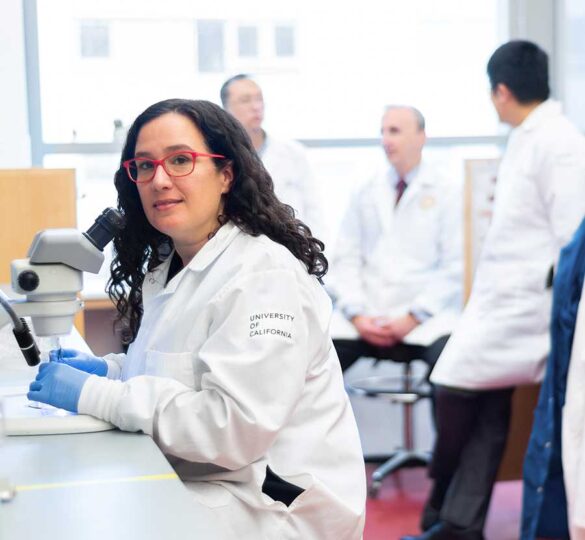Catalyst for a Cure: 2024 Research Update
The Catalyst for a Cure research teams are generating insights and results as they seek new treatments and cures for glaucoma and other neurodegenerative diseases.

Glaucoma Research Foundation currently has two groundbreaking Catalyst for a Cure initiatives underway at once. The two research teams are innovating, sharing discoveries, and inspiring each other as they work toward finding new treatments and cures.
CFC3: The Catalyst for a Cure Vision Restoration Initiative principal investigators are Xin Duan, PhD (UC San Francisco), Yang Hu, MD, PhD (Stanford University), Anna La Torre, PhD (UC Davis), and Derek Welsbie, MD, PhD (UC San Diego).
The CFC3 Vision Restoration researchers have made excellent progress to date and have published their discoveries in peer-reviewed scientific journals. Based on their recent findings the scientists believe they have identified ways to accomplish all three of their goals: 1) preventing damage to the retinal nerve cells (retinal ganglion cells) that connect the eye to the brain, 2) restoring health to those retinal nerve cells that were damaged, and 3) replacing lost retinal nerve cells.
Their next steps will be identifying the best combination of genes to achieve the maximum preservation of vision in human-relevant models of glaucoma. They believe that clinical trials of nerve cell protection and enhancement may be possible in the next few years and see opportunities for stem cell replacement to move forward in models of glaucoma in the coming years as well.
CFC4: The Melza M. and Frank Theodore Barr Foundation Catalyst for a Cure Initiative to Prevent and Cure Neurodegeneration principal investigators are Sandro Da Mesquita, PhD (Mayo Clinic), Milica Margeta, MD, PhD (Mass Eye and Ear), Karthik Shekhar, PhD (UC Berkeley), and Humsa Venkatesh, PhD (Brigham and Women’s Hospital).
The CFC4 investigators in the Neurodegeneration Initiative have been testing specific tissues to compare between Alzheimer’s disease, glaucoma, and gliomas. Using bioinformatics techniques, they analyzed existing genetic data and their initial experimental data. Their results suggest several potential common targets for new treatments.
The team plans to continue their analysis of tissue from normal and disease models and from patients with these diseases. Their plan is to discover common molecular and cellular pathways across the three diseases of the central nervous system that could be used to advance diagnosis and treatment of these blinding and fatal diseases.
Video: 2024 Research Progress
Posted on August 8, 2024.